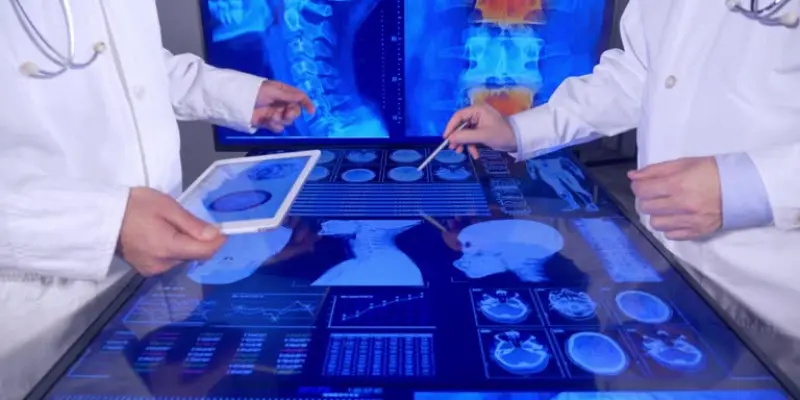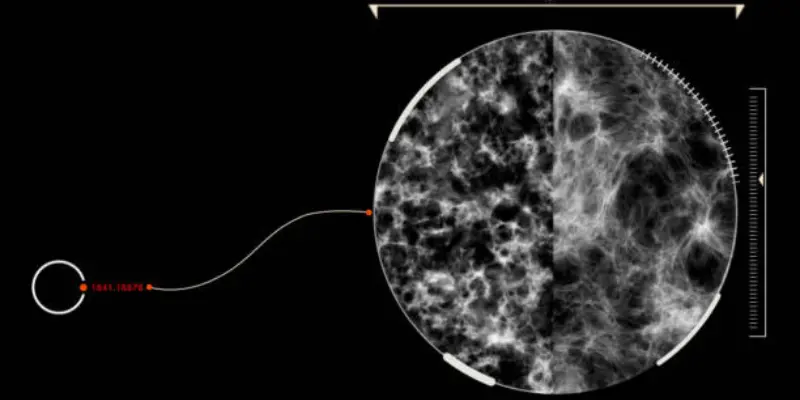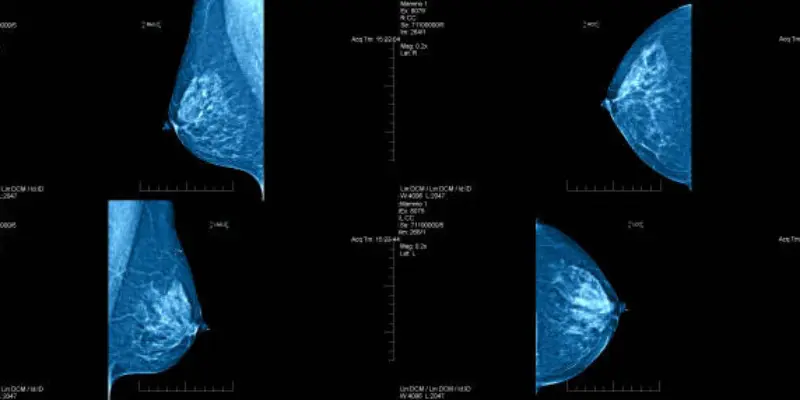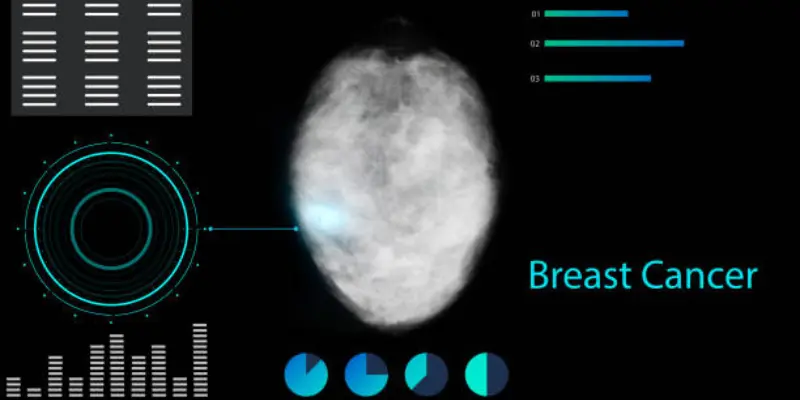AI for Mammograms: How Smart Tools Detect Breast Cancer Early
Published: 6 May 2025
Each year, millions of women get mammograms to check for breast cancer. But reading these X-ray images takes time and can sometimes lead to missed signs. This is where AI for Mammogram comes in. AI is like a smart computer that can learn and help with tasks. In mammograms, AI helps doctors read images faster and spot problems more accurately.
In this blog, you will learn how AI works in mammograms, what it does and why it matters. There will also be real life examples, the benefits and what you need to know as a patient or as a care provider.
Let’s get started. Keep reading, you will find out some interesting facts.

Traditional Methods Used for Mammogram
Before smart tools like AI came along, doctors used regular methods to read mammograms. These methods worked well but had some limits.
What Happens in a Traditional Mammogram?
In a traditional mammogram, an X-ray machine takes pictures of the breast. A radiologist, who is a doctor trained to read images, looks at those pictures. They check for any lumps, thick areas or spots that look different.
This method depends a lot on the doctor’s skill and experience. If the signs are small or not very clear, they can sometimes be missed.
Common Issues with Traditional Reading
- Human Errors: Even expert eyes can miss tiny signs of cancer.
- Different Opinions: One doctor may see something and another may not. This causes confusion and delays.
- Time-Consuming: Reading hundreds of mammograms each day can be tiring and that may affect accuracy.
Example
Imagine a busy hospital where one radiologist checks 100 mammograms in a day. With so many images, it’s hard to stay sharp for all the images. This can lead to delays or even small mistakes.
Why These Methods Need Help
Traditional ways are still important. But as breast cancer cases rise, doctors need extra support. That’s why tools like AI for mammograms are now being used. They help doctors work faster and with more confidence.
How AI Works in Mammograms
AI may sound like a big, robotic word in healthcare. But in simple terms, it means a smart computer that learns from data. In mammograms, AI helps doctors look at breast X-rays in a smarter and faster way.
AI Looks for Patterns
When a mammogram is taken, AI scans the image. It looks for patterns or changes that may not be easy to see. These could be small lumps, odd shapes or tiny spots that could mean something is wrong.
AI has already looked at thousands or even millions of other mammogram images. So it knows what to look for. It compares each new image to what it has already learned.
It Highlights Areas of Concern
If AI finds something that looks unusual, it marks it. This helps the doctor take a closer look. It’s like a second set of eyes that never gets tired.
It Supports the Doctor’s Decision
AI does not make the final decision. A trained doctor still checks the image and decides what happens next. But with AI’s help, they can be more confident and spot problems earlier.

Also Read: AI Stethoscope in Healthcare
Benefits of Using AI in Mammograms
AI is making mammogram screenings better in many ways. It helps doctors to work faster, catch more problems early and give better care to patients.
Let’s look at the main benefits of using AI for mammogram screening.
1. Faster Results
AI can scan mammogram images very quickly. What might take a doctor several minutes, AI can do in seconds. This means patients don’t have to wait long to get their results. Faster results also help doctors treat any problems sooner.
Some hospitals use AI to sort images. If AI finds something serious, it puts that image at the top of the list so doctors can check it first.
2. More Accurate Detection
AI tools have studied thousands of breast X-rays. They know what early signs of cancer look like, even the very small ones. This helps doctors find tiny lumps or strange spots that might be missed in a busy clinic.
AI can find a small tumor that is hard to see with the human eye. The doctor then confirms it with a closer look and helps the patient to start treatment early.
3. Fewer Mistakes
Sometimes mammogram results are wrong. A test may say there’s a problem when there isn’t (false positive). Or it may miss a real issue (false negative).
AI helps reduce these mistakes. It checks each image carefully and flags any area that looks different from normal.
This gives doctors a second opinion and helps them make better decisions.

4. Helps in Areas with Few Doctors
Not every clinic has expert radiologists. In some towns or small hospitals, only one doctor may look at all the mammograms. AI tools can help fill this gap. They give support in places where extra help is needed the most.
In rural areas, AI helps local doctors by checking images first. Then they send the important ones to a specialist for review.
5. Supports Doctor Confidence
AI is like a helpful assistant. It doesn’t replace doctors, rather it works with them. With AI’s support, doctors feel more confident that they have made the right call. This improves patient trust too.
Suggested Articles to read: AI Companies in Medical Imaging and Radiology AI Companies
Real-Life Examples
AI is already helping doctors all around the world to carefully read mammograms. Let’s look at some real-life examples where AI for mammograms made a big difference.
Example 1: Google Health’s AI Beat Expert Radiologists
In a large study done by Google Health, researchers built an AI system to read mammograms. The tool looked at thousands of breast scans from the U.S. and the UK. It did something amazing and found breast cancer more accurately than six expert doctors.
It also reduced false positives by 5.7% in the U.S. and 2.7% in the UK, meaning fewer women were told they might have cancer when they didn’t.
👉 This showed that AI can support doctors and help them avoid common mistakes.
📌 Source: Nature – McKinney 2020
Example 2: Lunit INSIGHT MMG at Severance Hospital in South Korea
At Severance Hospital in South Korea, doctors began using Lunit INSIGHT MMG, an AI tool that helps read mammogram images. The AI highlights areas that might show signs of cancer, making it easier for doctors to spot potential issues.
In one case, the AI flagged a small abnormality that the doctor initially missed. Upon closer examination, it turned out to be early-stage breast cancer. The patient received treatment quickly and had a successful recovery.
👉 Lunit’s AI is now used in over 600 hospitals worldwide, helping doctors find cancer earlier and more accurately.
📌 Source: Lunit Official Website
Example 3: Kheiron Medical’s AI Tool Mia in NHS Breast Cancer Screening
The UK’s National Health Service (NHS) has initiated a significant trial utilizing Mia which is an AI tool developed by Kheiron Medical to assist in breast cancer screening. In this trial, Mia analyzed mammogram images to detect signs of breast cancer. The AI tool not only identified all the cancers previously flagged by human doctors but also discovered additional cases that had been missed. This capability highlights Mia’s potential to enhance early detection and improve patient outcomes.
The trial, involving over 10,000 mammograms, demonstrated that Mia could reduce the average waiting time for results from 14 days to just 3 days, offering significant benefits in terms of patient experience and treatment planning. Given these promising results, the NHS plans to expand the use of Mia in breast cancer screening programs.
📌 Source: CNN

Challenges and Concerns
While AI for mammogram screenings offers many benefits, there are also some challenges and concerns that need to be addressed. Let’s look at a few important ones.
🔴 A. Data Privacy and Security
AI tools like Mammogram AI need access to large amounts of medical data to function properly. This data usually includes sensitive information like your personal health records. Protecting this data is very important.
For example, if the data is not handled properly, it could get into the wrong hands. This could lead to privacy breaches or misuse of personal health information.
What Can Be Done?
Hospitals and AI companies are working hard to follow strict data privacy laws like GDPR (in Europe) and HIPAA (in the U.S.). These laws help protect your data and ensure it’s used only for its intended purpose.
🔴 B. Trust and Accuracy
One of the biggest concerns about AI for mammograms is whether we can trust it. While AI can detect cancer, it isn’t perfect. There have been times when AI tools missed signs of cancer or made mistakes.
What Can Be Done?
Experts suggest that AI should always work alongside human doctors, not replace them. AI as a second reader is the best approach right now, where it assists doctors in making more accurate decisions, rather than making decisions on its own.
🔴 C. Bias in AI Models
AI tools learn from the data they are trained on. If the data used to train an AI system is biased—meaning it comes from only one group of people or certain types of mammogram images—the AI could become less effective for other groups of people.
For example, if an AI is trained mostly on data from white women, it might struggle to identify breast cancer in women of color.
What Can Be Done?
AI developers must use diverse datasets that represent different races, ages and medical histories. This way, the AI can be more accurate for all types of people.
🔴 D. Cost and Access
Not all hospitals or clinics can afford the latest AI tools. Even though AI can improve the quality of mammograms, it can be expensive to implement and maintain. Smaller hospitals, especially in low-income areas, might not have access to these tools.
What Can Be Done?
Governments and organizations can work together to make AI for mammograms more affordable and accessible. This could include offering funding or subsidies to smaller clinics and hospitals.
🔴 E. Over-Reliance on Technology
Relying too much on AI could be risky. If doctors begin to trust AI without question, they might miss something important. AI tools are designed to support, not replace the expertise of trained medical professionals.
What Can Be Done?
Doctors need proper training to use AI tools correctly. They should always review the AI results and make the final decisions. Combining human expertise with AI can lead to the best outcomes.
The Future of AI in Mammogram
AI for mammograms is growing fast. But this is just the beginning. The future looks even brighter with smarter tools, better results and easier access for everyone.
Let’s explore what’s coming next.
AI That Learns Over Time
Right now, most AI tools are trained once and used over and over. But in the future, AI will keep learning from new cases. This means it can get better with time just like a doctor who learns more with experience.
Making AI Available in More Places
Today, many top hospitals use AI. But small clinics or hospitals in poor areas may not have access. In the future, we expect AI for mammograms to become more affordable and easy to use, even on mobile devices.
Smarter, Faster and More Accurate AI
AI tools will become faster and more precise. They may be able to spot very small tumors that even experts miss. Some tools may also help doctors decide which treatment is best based on the cancer’s type.
AI + Human Experts = Best Team
The future of mammogram screening won’t be just AI or just doctors, it will be both working together. AI will act like a smart assistant that supports radiologists. It won’t replace them. Instead, it will give them extra tools to make better decisions.
Real-Life View:
Many hospitals already use AI as a second reader. In the future, this could become the standard everywhere, making screenings safer and more accurate for everyone.
Better Safety and Rules
As AI grows, so will the need for safety checks and strong rules. Governments and health organizations will work together to make sure all AI tools are tested, approved and safe to use.
Conclusion
So guys! In this article, we’ve covered AI for mammograms in detail.
From what I’ve seen, using AI during breast screenings makes a real difference. It gives doctors extra help and gives patients more peace of mind. As someone who’s deeply into healthcare tech, I believe AI can be a game-changer, especially in early cancer detection. It’s very smart, fast and can save lives.
If you are planning your next mammogram, I recommend choosing a clinic that uses AI tools.
👉 Take charge of your health—ask your doctor about AI options today!
FAQs About AI for Mammograms
Here are answers for your frequently asked questions:
Yes, regular mammograms work well but they can sometimes miss small signs of cancer. AI adds an extra pair of eyes and helps doctors catch what’s easy to overlook. It does not replace your mammogram, it just makes it better.
No, AI doesn’t replace your radiologist. It works like a smart assistant, helping the doctor find things faster and more accurately. Your doctor still makes the final decision.
It depends on the hospital or clinic. Some may charge a little extra, while others include AI at no added cost. It’s best to ask your provider before your appointment.
Some insurance plans cover it and others don’t yet. Coverage is growing as more hospitals use AI tools. Always check with your insurance company first.
Yes, especially if you have dense breast tissue or past family history. AI can spot small changes that doctors might miss. It gives you more confidence in your results.
Not everywhere yet. Big hospitals and research centers use it more often but it’s slowly reaching smaller clinics. Over time, access will grow.
AI scans the image pixel by pixel and looks for patterns linked to breast cancer. It highlights areas that need a second look. This helps doctors review faster and with more accuracy.
Yes, AI tools go through many tests before hospitals use them. They are reviewed by medical experts and often tested side-by-side with real doctors. But it’s always your doctor who gives the final call.
Yes, in some places. Not all clinics use AI yet, so it’s a good idea to ask if they offer AI-assisted screening when you make your appointment.
AI is not perfect but it reduces human error. If something is unclear, your radiologist double-checks it. Think of AI as a helpful tool, not the only one making decisions.





